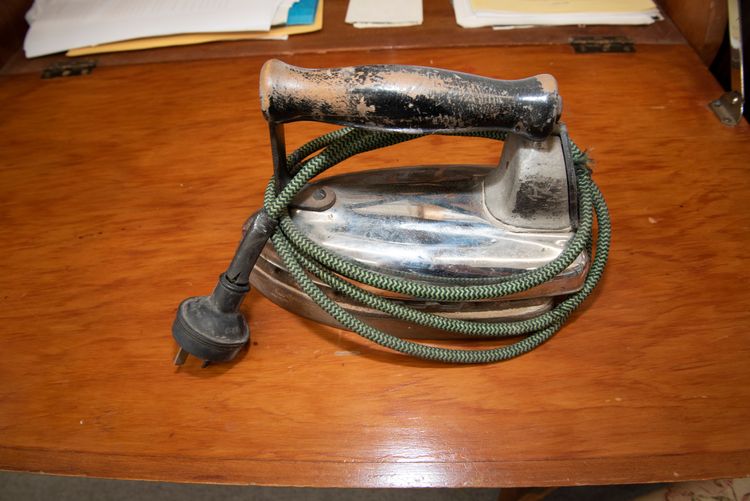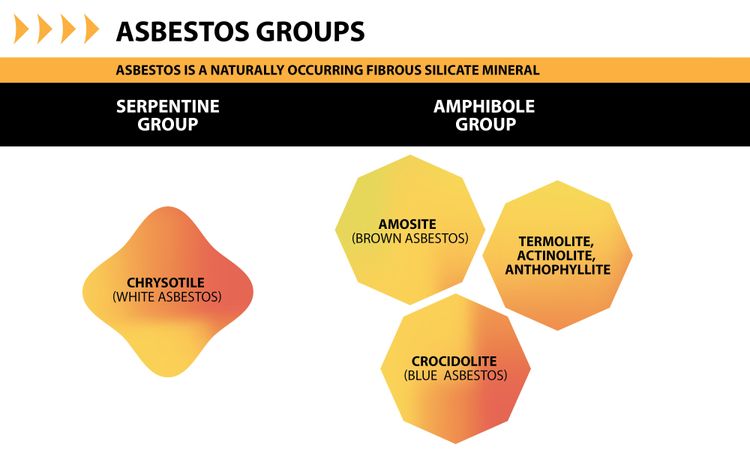Asbestos
Asbestos is a naturally occurring, fibrous silicate material that is found in rocks throughout the world.
 Where might we find asbestos?
Where might we find asbestos?
Chrysotile, or white asbestos, was the most commonly used asbestos, since its long curly fibres are flexible enough that it can be spun and woven into fabric. Many industrial, agricultural, and domestic appliances used white asbestos to shield machine parts from heat. Products that utilised it include (but are not limited to):
- Ovens
- Oven gloves
- Heat-resistant aprons
- Lagging for steam engines
- Brake pads for tractors
- Ironing boards
- Insulation for electric cabling
- Artificial snow
- WWI and WWII gas mask filters
Artificial snow and gas masks are commonly found in museum collections.
Amosite, or brown asbestos, the second most common asbestos in NZ, was used mainly in cement and pipe insulation.
Crocidolite, or blue asbestos, is the third most common asbestos in NZ. It is known for its heat and water resistance, so was used in ceiling tiles, brake pads, and ironing board pads.
The remaining three types (tremolite, actinolite, and anthophyllite) are much rarer and seldom used in industrial processes.
Importing blue and brown asbestos was made illegal in New Zealand in 1984, and it became illegal to import any products containing asbestos in 2016.
 Why is asbestos a hazard we need to think about?
Why is asbestos a hazard we need to think about?
Breathing in asbestos fibres can be harmful and possibly lead to diseases such as asbestosis, mesothelioma, and lung cancer.
Asbestosis causes long-term scarring and fibrosis of the lungs. It tends to be dose and time related. The more you work with asbestos, the higher your dose of fibres, and the more likely it is your lungs will be affected. Chronic exposure to small amounts of asbestos can have the same effect as massive exposure over a short period.
Mesothelioma and lung cancer are linked with exposure to asbestos (particularly the blue variety) and may appear 5 – 50 years after the initial exposure. You are more likely to get lung cancer if you are exposed to asbestos and you are a smoker.
 How can we confirm it is asbestos?
How can we confirm it is asbestos?
If you think that you have asbestos in your collection items, you should contact a WorkSafe-accredited contractor .
They can test for the presence and type of asbestos, either via a “wipe test” or by taking a small sample from your item (testing will destroy the sample). It is also possible to measure the concentration of asbestos fibres in an environment.
The contractor will talk you through this process, but if you would like more independent information regarding managing destructive sampling, contact our friendly Collections team at Tūhura Otago Museum.
 What does the law say about asbestos?
What does the law say about asbestos?
The Health and Safety at Work (Asbestos) Regulations 2016 say, “You are permitted to work with asbestos if you are involved in displaying, or preparing or maintaining for display, asbestos artefacts or things that include asbestos or asbestos containing material (ACM).” BUT Work places must make sure that exposure to airborne asbestos is eliminated, so far as is reasonably practicable. If it is not reasonably practicable, they must minimise exposure so far as is reasonably practicable.
This may mean ensuring all your items with asbestos are only displayed in glass cabinets, or, if the items are too large, you may have to encapsulate the asbestos or remove it completely.
The workplace exposure limit (WEL) is 100 fibres/L over an 8-hour period, for all types of asbestos.
 What do museums, galleries, libraries, and archives have to do if they have asbestos?
What do museums, galleries, libraries, and archives have to do if they have asbestos?
As part of your health & safety plan, you HAVE to include an asbestos management plan that:
- Identifies and labels asbestos-containing materials. This should include items you suspect of containing asbestos but haven’t confirmed.
- Assesses the risks from your asbestos-containing materials
- Has processes for accidents, incidents, emergencies, and disposal of asbestos
- Documents staff training
- Reviews the plan for effectiveness
Regulation 13 of the Health and Safety at Work Act stipulates that an asbestos management plan must include information about the identification of asbestos in a workplace; the decisions and reasons for managing the risk arising from it; and procedures for dealing with incidents and emergencies. The plan must be available to workers and reviewed every five years at minimum. It must also set out any health monitoring and training provisions for workers.
 If collections wish to dispose of asbestos, how can they do this safely?
If collections wish to dispose of asbestos, how can they do this safely?
You should contact a WorkSafe-accredited contractor.
Or, if you wish to discuss your options further, please feel free to contact the friendly Collections team at Tūhura Otago Museum .


